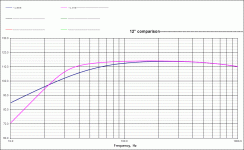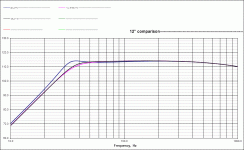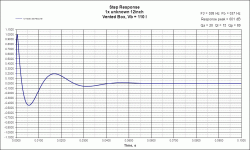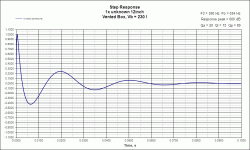Can anyone assist me with size of speaker cabinet needed for this 12” speaker?
40oz magnet., 8 ohm Freq., 30-4KHZ., FO35HZ., Sens. 94db., Qms 3.18., Qes 0.44., Qts 0.38., Vas 154.45L.
I am thinking a sealed enclosure for a 12” 3way system.
I do have a spare existing large cabinet being 3.84 cubic feet, would this be suitable? And I could modify it if necessary.
40oz magnet., 8 ohm Freq., 30-4KHZ., FO35HZ., Sens. 94db., Qms 3.18., Qes 0.44., Qts 0.38., Vas 154.45L.
I am thinking a sealed enclosure for a 12” 3way system.
I do have a spare existing large cabinet being 3.84 cubic feet, would this be suitable? And I could modify it if necessary.
Last edited:
software like unibox or winisd is your friend here 
Quickly putting into unibox it recommends about 55L for a .707 Qtc
modeling with 110L (pretty much your 3.84 cubic feet) gives a qtc of about 0.504
Both have an F3 around 69Hz. 55L has F10 around 40Hz and 110L has F10 around 33 Hz.
Tony.
Quickly putting into unibox it recommends about 55L for a .707 Qtc
modeling with 110L (pretty much your 3.84 cubic feet) gives a qtc of about 0.504
Both have an F3 around 69Hz. 55L has F10 around 40Hz and 110L has F10 around 33 Hz.
Tony.
Last edited:
Thanks however it is something I have never really dealt with. Can you explain a little more about what it all means? Do I need to make adjustments in cubic size plus or minus? How do I improve on what I have?software like unibox or winisd is your friend here
Quickly putting into unibox it recommends about 55L for a .707 Qtc
modeling with 110L (pretty much your 3.84 cubic feet) gives a qtc of about 0.504
Both have an F3 around 69Hz. 55L has F10 around 40Hz and 110L has F10 around 33 Hz.
Tony.
OK I probably should give some "definitions" I put that in quotes as this is my own understanding and shouldn't be taken as gospel as I may have muddled it a bit. Qtc is the alignment of the box. Basically it is a measure of the damping on the driver cone. How much resistance the air pressure in the box pushes back against the driver. 0.707 is considered optimal for efficiency and flatness. Higher numbers will have a bump in the lower bass response, lower will have a more gentle rolloff.
F3 is the frequency at which the sound pressure level (SPL) has dropped by 3db F10 is the frequency that the SPL has dropped by 10db.
The figures for F3 and F10 for both boxes seemed a bit high to me, but I've not ever done any large woofers in a sealed enclosure before. The driver models ok in a vented enclosure of 110L as well.
Attached is the spl modelling for the sealed and vented 110L enclosure to give an idea of the differences. <strike> Light blue</strike> Violet is vented.
Sorry if that is a bit vague, someone with more experience of large woofers in sealed enclosures may be better able to say if this is a good or bad result.
Tony.
F3 is the frequency at which the sound pressure level (SPL) has dropped by 3db F10 is the frequency that the SPL has dropped by 10db.
The figures for F3 and F10 for both boxes seemed a bit high to me, but I've not ever done any large woofers in a sealed enclosure before. The driver models ok in a vented enclosure of 110L as well.
Attached is the spl modelling for the sealed and vented 110L enclosure to give an idea of the differences. <strike> Light blue</strike> Violet is vented.
Sorry if that is a bit vague, someone with more experience of large woofers in sealed enclosures may be better able to say if this is a good or bad result.
Tony.
Attachments
Last edited:
...modeling with 110L (pretty much your 3.84 cubic feet) gives a qtc of about 0.504...
Tony.
looks like it responds nicely
though I'm confused about a few specs
for a 12", either the Fs is higher, or the SPL specs have been over rated
what kind of surround does it have ? ... PA or Hifi ?
Running your specifications thru WINbeta simulation, we find first off the Efficiency Bandwidth Product is at 79.54, preferable for a ported alignment. Offhand, I did run the SIM for sealed & it really fell down flat on its face, not good.
For the "preferred" ported tuning, I got an enclosure of 126.8 Liters, an Fb( Frequency box tuning) of 37.21 hertz, an "F3"...-3.06Db at 37.33 Hertz, OK I guess, but a bit high.
Re-tuning with an Fb of 34 hertz and we get a deeper F3 of -3.02 Db at 31.03 hertz, .....better!, but the downfall is the considerable enclosure size now of 230 liters.
You really can't get something for nothing, a trade-off. Wanting for the deepest bass tones will require the biggest of the boxes.
Yes, one can compensate with lots of EQ adjustments aiming for the smallest of the enclosures, but why not build it best to begin with?
Just my two cents.
__________________________________________________Rick......
For the "preferred" ported tuning, I got an enclosure of 126.8 Liters, an Fb( Frequency box tuning) of 37.21 hertz, an "F3"...-3.06Db at 37.33 Hertz, OK I guess, but a bit high.
Re-tuning with an Fb of 34 hertz and we get a deeper F3 of -3.02 Db at 31.03 hertz, .....better!, but the downfall is the considerable enclosure size now of 230 liters.
You really can't get something for nothing, a trade-off. Wanting for the deepest bass tones will require the biggest of the boxes.
Yes, one can compensate with lots of EQ adjustments aiming for the smallest of the enclosures, but why not build it best to begin with?
Just my two cents.
__________________________________________________Rick......
Light blue is vented.
Sorry if that is a bit vague, someone with more experience of large woofers in sealed enclosures may be better able to say if this is a good or bad result.
FWIW, 'blue' displays the sealed alignment for me.
Not vague at all nor is either alignment good or bad, just each has a different set of design trade-offs. If its specs are ~accurate, venting the existing cab and experimenting with different amounts of damping over the vent, including blocking it off to find what sounds best overall in room seems the obvious choice to me.
GM
johncee1945,
Post pictures.
From your post the T/S parameters are incomplete, do you have the complete set of T/S parameters i.e. Sd=?, Re=? or link to model of driver or pdf?!
Do a search on google and download WinIsd for the design of the enclosure. Now, a 3-Way might be an impossible task for you @101. So I recommend using another kit (Troels High Efficiency Speaker constructions or other) as a start for your project, changing only the woofer.
DIY Loudspeakers
In a 2/3-Way the Q of the speaker/driver is not a fixed one () but might be variably high due to crossover or BSC or type of designed loudspeaker enclosure/alignment. So if you don't know what this is or don't know how to design crossovers better you go to an option where someone does that job for you. You can cut the lamber...

http://www.diyaudio.com/forums/mult...-speaker-system-using-dual-focal-13v7511.html
tinitus,
From Fs looks like a between rubber half roll and a pleated cloth surround (35Hz).
Something between a Focal or AE speaker and a Supravox or B&C (higher).
AE Speakers --- Superb Quality, Unforgettable Performance, Definitely.
285 GMF SUPRAVOX
http://www.teamaudio.fr/media/catalog/product/datasheet/bc/12PH32-8.pdf
Post pictures.
From your post the T/S parameters are incomplete, do you have the complete set of T/S parameters i.e. Sd=?, Re=? or link to model of driver or pdf?!
Do a search on google and download WinIsd for the design of the enclosure. Now, a 3-Way might be an impossible task for you @101. So I recommend using another kit (Troels High Efficiency Speaker constructions or other) as a start for your project, changing only the woofer.
DIY Loudspeakers
In a 2/3-Way the Q of the speaker/driver is not a fixed one () but might be variably high due to crossover or BSC or type of designed loudspeaker enclosure/alignment. So if you don't know what this is or don't know how to design crossovers better you go to an option where someone does that job for you. You can cut the lamber...
http://www.diyaudio.com/forums/mult...-speaker-system-using-dual-focal-13v7511.html
tinitus,
From Fs looks like a between rubber half roll and a pleated cloth surround (35Hz).
Something between a Focal or AE speaker and a Supravox or B&C (higher).
AE Speakers --- Superb Quality, Unforgettable Performance, Definitely.
285 GMF SUPRAVOX
http://www.teamaudio.fr/media/catalog/product/datasheet/bc/12PH32-8.pdf
FWIW, 'blue' displays the sealed alignment for me.
GM
That's my colourblindness.. I should have checked with whatcolour
Tony.
OK many thanks, the reccomendations on this page saved a big disapointment. Imagine putting in the time and effort and the sound falls down miserably. So I will forget the existing speaker box and move towards a larger enclosure for a ported arrangement of 126 litres.Running your specifications thru WINbeta simulation, we find first off the Efficiency Bandwidth Product is at 79.54, preferable for a ported alignment. Offhand, I did run the SIM for sealed & it really fell down flat on its face, not good.
For the "preferred" ported tuning, I got an enclosure of 126.8 Liters, an Fb( Frequency box tuning) of 37.21 hertz, an "F3"...-3.06Db at 37.33 Hertz, OK I guess, but a bit high.
Re-tuning with an Fb of 34 hertz and we get a deeper F3 of -3.02 Db at 31.03 hertz, .....better!, but the downfall is the considerable enclosure size now of 230 liters.
You really can't get something for nothing, a trade-off. Wanting for the deepest bass tones will require the biggest of the boxes.
That is the best way to go isn't it?
Considering I have already purchased the speakers. The speakers are
Dai-ichi 150-12 with a 40oz magnet and I have no other info than what I posted.
Last edited by a moderator:
The difference between the 110L and 126L is minimal. Attached is unibox simulation for both with 37Hz tuning. It was the 230L size that rick was saying had the much lower bass.
I would not bother building a new box if you are only increasing to 126L.
The main downside (apart from size) with going to 230L is the poorer transient response.. As has been mentioned by others already everything is a tradeoff.
first pic is the comparison of 230L 34Hz (blue) 110L (pink) and 126L(black) both tuned to 37 Hz (the original one I posted was tuned to 34Hz).
Next two are 110L transient response and 230L transient response. The bigger the wiggles the longer it takes for the speaker to return to rest after being excited by the incoming signal.
Tony.
I would not bother building a new box if you are only increasing to 126L.
The main downside (apart from size) with going to 230L is the poorer transient response.. As has been mentioned by others already everything is a tradeoff.
first pic is the comparison of 230L 34Hz (blue) 110L (pink) and 126L(black) both tuned to 37 Hz (the original one I posted was tuned to 34Hz).
Next two are 110L transient response and 230L transient response. The bigger the wiggles the longer it takes for the speaker to return to rest after being excited by the incoming signal.
Tony.
Attachments
That is the best way to go isn't it? Considering I have already
purchased the speakers. The speakers are Dai-ichi 150-12 with
a 40oz magnet and I have no other info than what I posted.
If you have the means, measure your woofer TS parameters.
It would be very well worth it. You probably have a sound card
of some sort and that is already half way to success. You asked
about the best way, this is it. After that, simulation will come
into play.
I would have to go with Tony here, the difference from 110 to 126 liters isn't really worth the effort. Yes, really deep registers require big ol' boxes, but one must take into account the time, effort & REAL floorspace such a box would entail.
No you shouldn't even consider building such a tall & skinny enclosure to get to these volumes as the enclosure starts acting like a pipe-organ tube. Not good.
Study Tonys' graphs as they reveal much.....
______________________________________________________Rick..........
No you shouldn't even consider building such a tall & skinny enclosure to get to these volumes as the enclosure starts acting like a pipe-organ tube. Not good.
Study Tonys' graphs as they reveal much.....
______________________________________________________Rick..........
This simulated 230 liter model requires a speaker that stands 55 inches high! 55x17x15inches 229.8liters.
Something seems out of kilter. Is it due to the way the speaker is made?
The pipe organ notes that Richard mentions makes your enclosure a mass loaded transmission line (MLTL). These come with their own issues and unique characteristics. Results can be very good if designed properly, but are difficult to get right. Most use close to Golden Ratio for standard enclosure dimensions to minimize standing waves reducing this effect.
OK many thanks, the reccomendations on this page saved a big disapointment. So I will forget the existing speaker box and move towards a larger enclosure for a ported arrangement of 126 litres.
That is the best way to go isn't it?
You're welcome!
Again, nothing wrong with using the existing cab, but if you want more bass, then a significantly larger cab is required.
Short of a large horn, an acoustically large, high aspect ratio, vented cab alignment [MLTL] has proven to be the best overall alignment for getting the most LF out of a driver at high SQ with the trade-off being a lower peak power handling in the LF unless there’s significant room gain.
At nearly 2x its Vas spec [~8.35 ft^3 net/32 Hz Fb], this MLTL has sufficient tuning flexibility that measuring a driver’s specs usually doesn’t change things except give extra insight for fine tuning in a sim before empirically experimenting. Most times though, once damped to ‘taste’, very few bother with experimenting with different vent size, lengths.
L = 60”
CSA = 241.786”^2 [suggest 19.75” W x 12.25” D]
Zdriver = 23.71”
Zport = 54”
Dport = 6”
Lport = 1”
All dims inside [i.d.] and approximate. Sim assumes a Re = 5.8 ohms, Sd = 506.7 cm^2, Le = 2.0 mH and a stuffing density = 0.25 lbs/ft^3 of polyfil.
GM
Attachments
You're welcome!
Again, nothing wrong with using the existing cab, but if you want more bass, then a significantly larger cab is required.
Short of a large horn, an acoustically large, high aspect ratio, vented cab alignment [MLTL] has proven to be the best overall alignment for getting the most LF out of a driver at high SQ with the trade-off being a lower peak power handling in the LF unless there’s significant room gain.
At nearly 2x its Vas spec [~8.35 ft^3 net/32 Hz Fb], this MLTL has sufficient tuning flexibility that measuring a driver’s specs usually doesn’t change things except give extra insight for fine tuning in a sim before empirically experimenting. Most times though, once damped to ‘taste’, very few bother with experimenting with different vent size, lengths.
I appreciate the scientific and objectivity of you guys. So all is not lost, I was ready to throw out the baby with the bathwater, at least on ebay. I think the present speakers should have enough bass for grounds for divorce. So I will use the present size of 3.84 cubic feet. That resolves another problem too, the large space or footprint required in the loungeroom if I went to a larger size.
Am I on the right track seeking a large wide range mid 6", 7" or 8"? Or can the smaller 5" or 5 1/2" wide range mids "cut the mustard" without being overpowered by the 12" bass? Any suggestions greatfully accepted as long as they are not too expensive.
Last edited by a moderator:
I doubt if there would be much difference between 110L & 126L, nothing that couldn't be tweaked in the tuning anyway....
If you've already got the box wouldn't take much effort to try it...???
oops, didn't see the 2nd page of posts...
re:"what size and length port tube" - this is where you need to get familiar with Unibox or Winisd, makes answering this question very easy...
http://www.linearteam.dk/default.aspx?pageid=newdriver
WINISD suggests ~ 37Hz tuning, the length depends on what diameter pipe you use (Smaller dia gives shorter pipe)
If you've already got the box wouldn't take much effort to try it...???
oops, didn't see the 2nd page of posts...
re:"what size and length port tube" - this is where you need to get familiar with Unibox or Winisd, makes answering this question very easy...
http://www.linearteam.dk/default.aspx?pageid=newdriver
WINISD suggests ~ 37Hz tuning, the length depends on what diameter pipe you use (Smaller dia gives shorter pipe)
Last edited:
With the parameters above for a 110liter box, what size and length port tube would I require?
How much power is available?
GM
- Status
- This old topic is closed. If you want to reopen this topic, contact a moderator using the "Report Post" button.
- Home
- Loudspeakers
- Multi-Way
- Cabinet size help




![Dai-ichi 150-12 [johncee1945] 32 Hz MLTL.gif](/community/data/attachments/378/378051-27173f29985379fb152edec5c4f7e1e5.jpg)